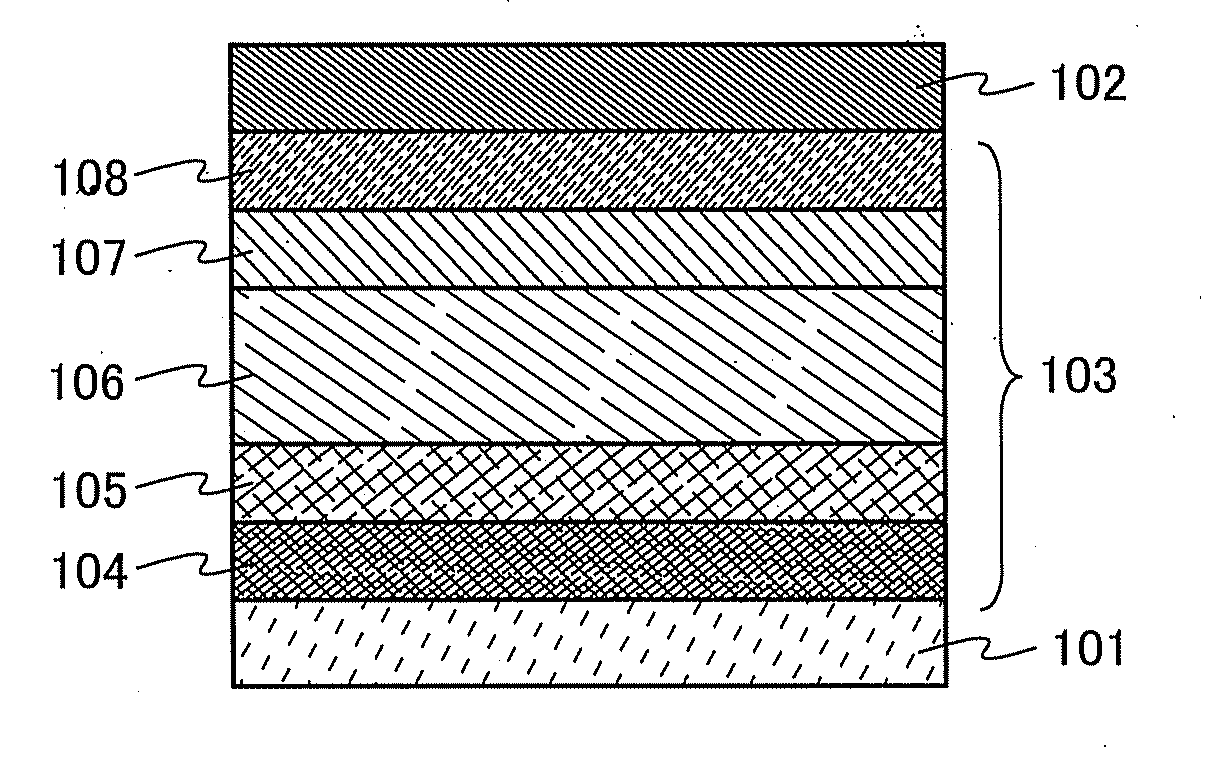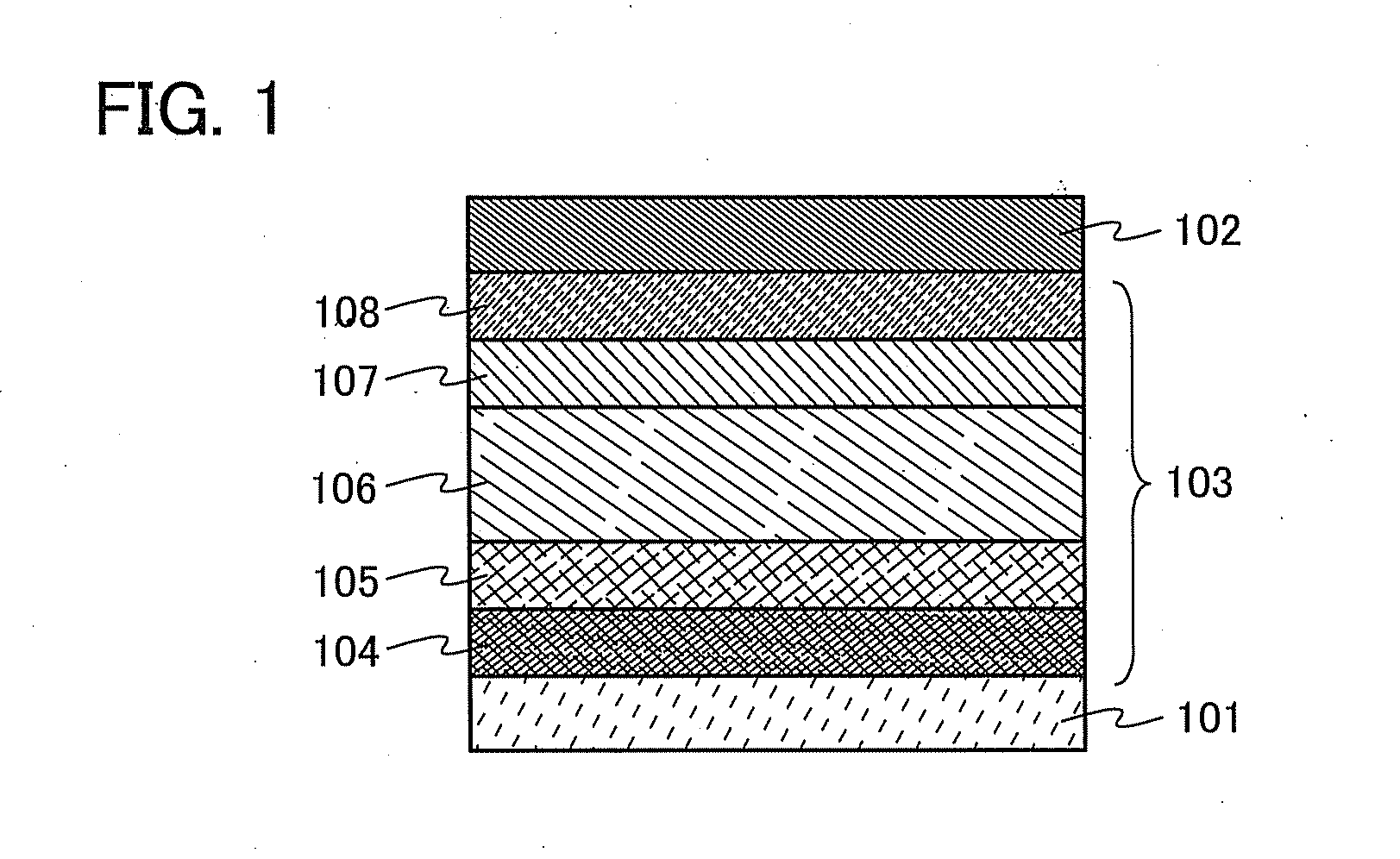Light-Emitting Element and Light-Emitting Device
a technology of light-emitting elements and light-emitting devices, which is applied in the direction of solid-state devices, semiconductor devices, thermoelectric devices, etc., can solve the problems of reducing the extraction efficiency of light from the light-emitting element, and achieves the reduction of power consumption, the increase of the extraction efficiency of light from the light-emitting element, and the effect of high visible light transmittan
- Summary
- Abstract
- Description
- Claims
- Application Information
AI Technical Summary
Benefits of technology
Problems solved by technology
Method used
Image
Examples
embodiment 1
[0048]A light-emitting element in accordance with one embodiment of the present invention includes at least one EL layer and a pair of electrodes between which the EL layer is provided. The EL layer contains a composite material which includes an organic compound having a high hole-transport property and an electron acceptor and in which charge-transfer interaction does not occur easily.
[0049]FIG. 1 illustrates a structure example of the light-emitting element in accordance with one embodiment of the present invention. The light-emitting element illustrated in FIG. 1 includes an anode 101 and a cathode 102, which correspond to the pair of electrodes, and an EL layer 103 provided between the anode 101 and the cathode 102.
[0050]In the example in FIG. 1, the EL layer 103 includes a hole-injection layer 104, a hole-transport layer 105, a light-emitting layer 106, an electron-transport layer 107, an electron-injection layer 108, and the like. Specifically, the hole-injection layer 104, t...
embodiment 2
[0072]This embodiment shows results of the evaluation of composite materials each including an organic compound having a high hole-transport property and an electron acceptor, using an ESR method.
[0073]Samples used for the measurements are described below. All the samples were formed by co-evaporation of an organic compound and an electron acceptor over a quartz substrate having a size of 2.8 mm×20 mm, so that layers formed by the co-evaporation each contained the composite material including the organic compound and the electron acceptor.
[0074]The way how the samples were formed is specifically as follows. First, the quartz substrate was fixed to a holder in a vacuum evaporation apparatus so that a surface over which the composite material was to be formed by evaporation faced downward. After the pressure in the vacuum evaporation apparatus was reduced to 10−4 Pa, the organic compound and molybdenum(VI) oxide, which was an electron acceptor, were co-evaporated, thereby forming a la...
embodiment 3
[0088]In this embodiment, a layer containing a composite material which includes an organic compound having a high hole-transport property and an electron acceptor and in which charge-transfer interaction does not occur easily is provided in contact with the cathode 102 in the EL layer 103.
[0089]FIG. 4 illustrates a structure example of the light-emitting element in accordance with one embodiment of the present invention. The light-emitting element illustrated in FIG. 4 includes an anode 101 and a cathode 102, which correspond to the pair of electrodes, and an EL layer 103 provided between the anode 101 and the cathode 102.
[0090]In the example in FIG. 4, the EL layer 103 includes a charge generation layer 110 in addition to the hole-injection layer 104, the hole-transport layer 105, the light-emitting layer 106, the electron-transport layer 107, the electron-injection layer 108, and the like. Specifically, the hole-injection layer 104, the hole-transport layer 105, the light-emittin...
PUM
 Login to View More
Login to View More Abstract
Description
Claims
Application Information
 Login to View More
Login to View More - R&D
- Intellectual Property
- Life Sciences
- Materials
- Tech Scout
- Unparalleled Data Quality
- Higher Quality Content
- 60% Fewer Hallucinations
Browse by: Latest US Patents, China's latest patents, Technical Efficacy Thesaurus, Application Domain, Technology Topic, Popular Technical Reports.
© 2025 PatSnap. All rights reserved.Legal|Privacy policy|Modern Slavery Act Transparency Statement|Sitemap|About US| Contact US: help@patsnap.com



